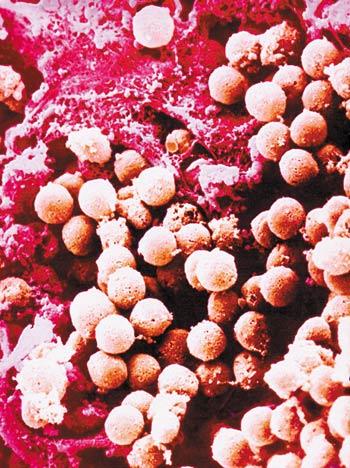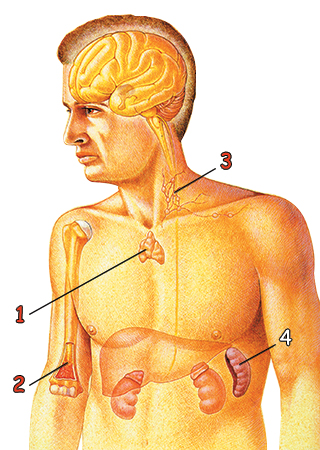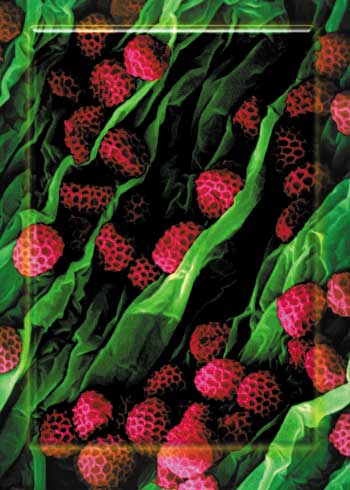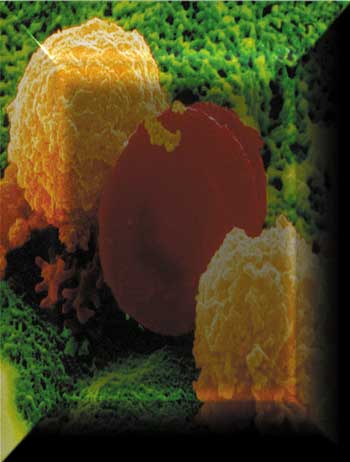Organs Employed in Defence
Warrior Production Centre: The Bone Marrow
 | |
| 1. Bone marrow | 2. Bone section |
When atom bombs were dropped on Hiroshima and Nagasaki, many people exposed to the radiation released by the explosions died 10 or 15 days later from internal bleeding or infection. Animal experiments conducted to explore what happened to such casualties revealed that whole-body radiation kills the generative cells in blood-forming and lymphoid organs. Without the cells responsible for clotting and for fighting invaders, the body dies. 6
The factory of these vital cells is the bone marrow. The interesting point is that many diverse products are produced in this factory. Some of the cells produced here play a role in the production of phagocytes, some in the coagulation of blood, some in the decomposition of substances. These cells differ in function just as they differ in their structure.
It is remarkable that a very special production system has been established for many different cells that work towards the same goal.
Here, there seems to be an impregnable barrier for the theory of evolution. This is because the theory of evolution claims that multi-celled organisms have evolved from one-celled organisms.
So, how can coincidentally formed cells build a system capable of producing new cells in the very structure they have constituted? This is similar to thousands of bricks, which have burst into the air as a result of an explosion at a brick factory, having fallen down on top of each other by chance and, in the process, making a brand new building. Moreover, in this building there must also be another factory to build new bricks.
It has to be remembered that the creation of a human body is a million times superior to that of a building. The cell, which is the building block of the body, has a design too perfect to be compared with any man-made product. This analogy between the cell and the brick has simply been made in order to clarify how deceitful the hypothesis of evolutionists is.
The Faculty in Us: The Thymus
 |
| Immune cells (T lymphocytes) trained in the thymus. |
On biological examination, the thymus would seem to be an ordinary organ without any particular function. The work it does, however, when studied in detail, is quite unbelievable.
In the thymus, the lymphocytes get some sort of training. No, you have not misread this. The cells receive training in the thymus.
Training is an information transfer, which can be exercised on beings with a certain level of intelligence. So there is an important point that needs mention here. What gives the training is a lump of meat, which is the thymus, and what receives it is a miniscule cell. In the last analysis, both are unconscious beings.
At the end of this training, lymphocytes are equipped with a very important body of information. They learn to identify the particular characteristics of the cells in the body. In some sense, the lymphocytes are taught the identities of the body cells. Finally, these cells leave the thymus loaded with information.
Thus, as the lymphocytes function in the body, they do not attack the cells, the identity of which they have been taught. Any other cell or foreign matter is attacked and destroyed by them.
For years, the thymus was considered to be a vestigial organ by evolutionist scientists and used as so-called evidence for evolution. In recent years, however, it has been revealed that this organ constitutes the wellspring of our defence system. After this was understood, evolutionists, who once proclaimed the thymus to be a vestigial organ, now advanced a totally opposite theory for the same organ. They claimed that the thymus did not exist before, and originated through gradual evolution. They still maintain that the thymus formed in a longer evolutionary period than many organs. However, without the thymus, or without its being fully developed, T cells could not have learned to identify the enemy and the defence system would not have functioned. Someone without such a system would not survive. Even your reading this sentence now is proof that the thymus was not created through a long evolutionary process, but has always existed, perfect and intact in all respects, since the advent of the first human being.
A Versatile Organ: The Spleen
 | |
| 1. Thymus | 3. Lymph Node |
| Organs functioning in the body's immune system | |
Another wondrous element of our defence system is the spleen. The spleen is made up of two parts: red pulp and white pulp. The fresh lymphocytes produced in the white pulp are first transferred to the red pulp and then join in the blood stream. A detailed study of the operations carried out in this organ, which is dark red in colour and located high up the abdomen reveals an extraordinary picture. Its quite difficult and complicated functions are what make it so wonderful and extraordinary.
The duties of the spleen, such as contributing to cell production, phagocytosis, conservation of red blood cells, and immunity construction, are at least as important as they are difficult. Certainly, the spleen is a lump of meat just like all our other organs. Yet it displays a performance and a degree of intelligence unexpected from a lump of meat. It organizes everything, not allowing any problems to occur, and works without rest. Indeed, the spleen works strenuously for the human from the moment of his birth, and continues its function as long as Allah wills.
Cell Production
The bone marrow of the baby in the mother’s womb is not entirely able to fulfill its function of producing blood cells. The bone marrow can perform this function only after birth. Would the baby be anaemic in the meantime?
No. At this stage, the spleen comes into play and takes control. Sensing that the body needs red blood cells, thrombocytes, and granulocytes, the spleen starts to produce these cells in addition to lymphocytes, which is its main duty.
The spleen, however, is an unconscious lump of meat. It is not capable of assuming such a responsibility. Besides, even if it did, how would it be equipped with the required information and components to produce the extremely complex cells and proteins? Allah, Who created the human body, created the spleen in such a way as to enable it to take on other responsibilities in addition its own task when necessary, and equipped it with the necessary stimulus and production systems.
Phagocytosis
 |
| He is Allah — the Creator, the Maker, the Giver of Form. To Him belong the Most Beautiful Names. Everything in the heavens and on the earth glorifies Him. He is the Almighty, the All-Wise. (Surat al-Hashr: 24) |
The spleen contains a large number of macrophages (cleaner cells). These engulf and digest old and damaged red blood cells, some damaged blood cells and some substances that are carried to the spleen through the blood.
There is a very important chemical recycling system at work here.
The macrophage cells in the spleen convert the haemoglobin protein, which is found in the composition of the red blood cells they have engulfed, to bilirubin, a bile pigment. Then, the bilirubin is released to the venous circulation and sent to the liver. In this form, it can be discharged out of the body along with the bile. However, the iron molecule found in the bilirubin which is about to be discharged out of the intestines along with the bile, is a rare material which is very valuable for the body. For this reason, iron is absorbed back in a certain region of the small intestines and from there, it first goes to the liver and then to the bone marrow. Here, the purpose is both to discharge the bilirubin, which is a harmful substance, and, at the same time, to regain the iron.
The bilirubin balance is crucial for our body. This is because even the slightest problem in this system would lead to serious outcomes. One of the best examples is that when bilirubin goes above a certain level, jaundice develops in the body. However, the cells in our body, as if they are aware of this danger, discharge the harmful materials from our body with a great precision while they select the useful ones among them and put them into use once again.
Red Blood Cell Storage
The skills of the spleen do not end here. The spleen stores a certain amount of blood cells (red blood cell and thrombocytes). The word "store" may conjure up an image of a separate compartment in the spleen that can be used for storage. The spleen, however, is a small organ, and it has no space to use as a storage room. In such cases, the spleen expands to make room for red blood cells and thrombocytes. A spleen enlarged due to some diseases may also have an enlarged storage space.
Contribution To War
When a microbial infection or any other malady develops in the body, the body mounts a defensive attack on this enemy, prodding the warrior cells to multiply. At such moments, the spleen enhances lymphocyte and macrophage production. Thus, the spleen also participates in the "emergency operation" that is launched at times when disease could harm the human body.
Another Production Centre: The Lymph Nodes
 |
| Is it you who create it or are We the Creator? (Surat al-Waqi'a: 59) |
In the human body, there is a police force and a police intelligence organization scattered throughout the body. In this system, there are also police stations which have policemen on guard, and which produce new policemen when required.
This system is the lymphatic system and the police stations are the lymph nodes. The policemen of the system are lymphocytes.
The lymphatic system as it stands is a miracle performed for the benefit of mankind. This system comprises of lymphatic vessels that are diffused throughout the body, lymph nodes that are located at certain spots on these vessels, the lymphocytes produced by lymph nodes, which patrol in the lymphatic vessels, and the lymph fluid circulating in the lymphatic vessels in which lymphocytes swim.
The system works as follows: The lymph fluid in the lymphatic vessels spread throughout the body makes contact with the tissues located around the capillary lymphatic vessels. The lymph fluid that returns to the lymphatic vessels right after this contact brings along some information about these tissues. These pieces of information are transmitted to the nearest lymph node located on the lymphatic vessels. If any hostile action has started in the tissues, its knowledge is forwarded to the lymph node through the lymph fluid.
In case any danger is sensed following the examination of the nature of the enemy, an alarm is given. At this point, the rapid production of lymphocytes and some other warrior cells starts in the lymph nodes.
After the production stage, the new soldiers are transported to the front where the battle is fought. These new soldiers will travel from the lymph nodes to the lymphatic vessels through the lymph fluid. The soldiers, which are diffused into the blood stream from the lymphatic vessels, finally reach the battleground. This is why the lymph nodes in the infected region swell first. This shows that the lymphocyte production has increased in that region.
Now, let us summarize the system:
- - A special transportation system that covers the length and breadth of body.
- - Lymph node stations dispersed throughout different regions of the body.
- - The intelligence operation directed at the enemy cells.
- - Production of soldiers according to the results of the intelligence report.
It is impossible for this system, which would collapse in the absence of even one of its elements, to have originated by developing gradually over time. For instance, a system with lymph nodes and lymphocytes, but without lymphatic vessels, would not be of any use. The system can work properly only if all its elements are created simultaneously.
Footnotes
6. Scientific American, September 1993, p. 65
